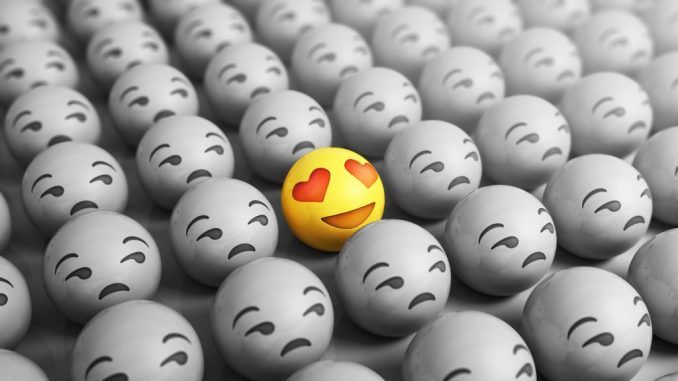
Illustration 125508467 © Ukrainian artist Igor Tokalenko | Dreamstime.com
In the age of hybrid meetings and events, the power of body language as a universal form of communication is losing its sway. Instead, you’ll have to focus on your emoji etiquette. Yep, that’s a thing.
In the dating department, peppering your sentences with an emoji or two could really help spice things up. That’s according to the 2022 Global Emoji Trend Report published by Adobe, which has found that 71% of respondents around the world believe emojis are “a must” in conversations when it comes to flirting.
For this year’s emotive report, the creative heavyweight surveyed 10,000 emoji users worldwide to look at how emojis have been helpful in communication and self-expression.
Too shy to ask your crush out? Try sending out some hints and good vibes with an emoji. In its research, Adobe has also learned that more than half (58%) of its participants are more likely to “use even more emoji” with somebody they’re interested in. The same percentage of people also feel more comfortable using emoticons to express their feelings to someone they like-like.
“Emoji make a lasting romantic impression. Not only is emoji use seen as an indicator of relationship success, but it also influences whether a second or third date is in the future,” Adobe says in an email to DesignTAXI. That’s reassuring.
Obviously, the choice of emoji matters.
In the US, users have ranked these emoticons as the ones that “make you more likable” on dating apps, with the first being ‘Face Throwing a Kiss’.
Images via Emojipedia
And here are America’s greatest turn-offs in terms of emojis, led by a s**thead:

Images via Emojipedia
Globally, the emoji that makes people seem more attractive is the ‘Smiling Face with Three Hearts’ icon, while the most obnoxious emoji is the eggplant.
For long-term relationships, emojis are also a way to keep the communication strong. “Over half (62%) of global users assume their relationship with someone is going well if they use more emoji when talking to each other,” explains Adobe.
Hearteningly, the report indicates a positive shift in moods from the year before. “The top five most-used emoji are happier in comparison to the previous year,” notes the study.
These are the top five most-used emojis of 2022 around the world:

Screenshot via Adobe
And here were last year’s most-used emojis:

Screenshot via Adobe
Even through graphics, miscommunications may arise. Over time, users give new meaning to emojis that may differ culturally.
Below are the three most misunderstood emojis:

Screenshot via Adobe
Don’t worry. They’re confusing us too. According to Emojipedia, the ‘Cowboy Hat Face’ can “convey a sense of exuberance, whimsy, confidence, adventure, or other sentiments.”
And the cherry icon may look innocuous, but it’s often perceived as a pair of breasts on TikTok and other social networks.
The upside-down smiley has a multitude of interpretations, from silliness to “sarcasm, irony, passive aggression,” and even “frustrated resignation,” as defined by Dictionary.com.
Importantly, emoji users are emphasizing the need for more diverse and representative icons. Beyond having their own heritage recognized, 60% of global users are keen on an option to customize emojis to match their personal appearance, with 62% wanting more personalization for emojis. Features like hairstyle or color (48%), eye color (38%), accessories and body type (38%) are of particular interest.
Users believe that making emojis more inclusive, as tiny as they are, could even do wonders for mental health. After all, emojis punctuate our sentences every day, and it’s always nice to see happy faces. Imagine a version of yourself that’s always smiling.
“Emoji have become a favorite form of creative self-expression for people everywhere,” says Kamile Demir, computer scientist at Adobe and Adobe representative on the Unicode Emoji Subcommittee. “As the creative industry leader and a member of the Unicode Consortium, we recognize the potential for emoji to promote inclusivity, spark cultural conversations and even positively impact mental health.”
That’s not all. There’s also sage advice for brands. Businesses might want to incorporate emojis into their marketing or calls to action, as 55% of global users have agreed that they are “more willing to buy an item using an emoji.”
Here are the emojis representing “products most likely to be purchased”:

Screenshot via Adobe
“The majority of global users are open to new ways of using emoji, such as confirming attendance at an event (66%), sending or receiving payments (41%) and communicating with a doctor (39%),” Adobe continues.
This is why even your website needs one.
[via
http://www.designtaxi.com/news/420372/Adobe-s-Global-Study-Reveals-Emojis-That-Make-You-Most-Or-Least-Attractive/

Leave a Reply